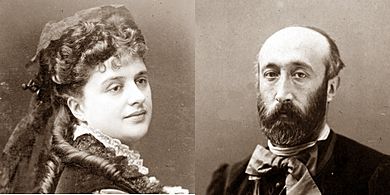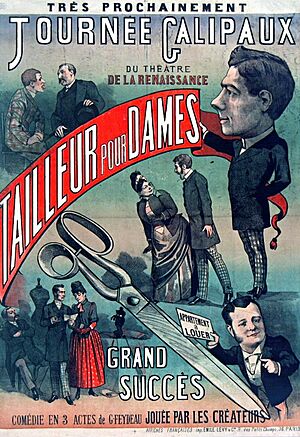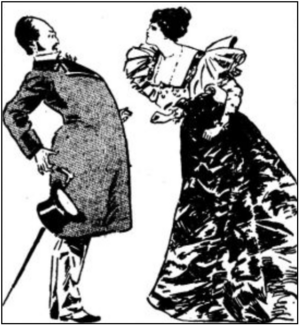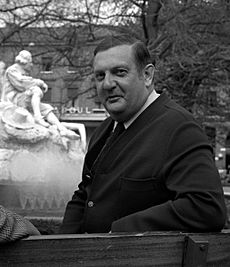Georges Feydeau facts for kids
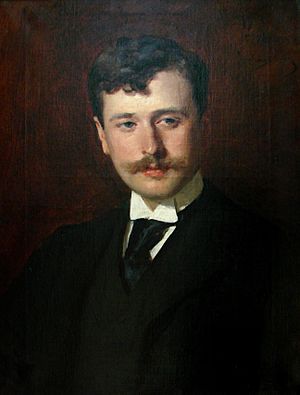
Georges-Léon-Jules-Marie Feydeau (born December 8, 1862 – died June 5, 1921) was a famous French writer of funny plays, called farces. He lived during a time known as the Belle Époque, a period of peace and prosperity in France. His plays, written between 1886 and 1914, are still enjoyed today around the world.
Georges Feydeau grew up in Paris in a family that loved art and books. From a young age, he was very interested in the theatre. As a child, he wrote plays and even organized his school friends into a drama group. When he was a teenager, he started writing short, funny speeches called monologues. Then he moved on to writing longer plays.
His first full-length comedy, Tailleur pour dames (Ladies' Tailor), was very popular. However, a few plays after that were not as successful. So, in the early 1890s, he took a break from writing. He studied how other great French comedy writers, like Eugène Labiche, created their plays. This helped him improve his own writing skills.
After this break, Feydeau wrote seventeen more full-length plays between 1892 and 1914. Many of these plays have become classics in theatres in France and other countries. Some of his most famous works include L'Hôtel du libre échange (The Free Exchange Hotel, 1894), La Dame de chez Maxim (The Lady from Maxim's, 1899), La Puce à l'oreille (A Flea in Her Ear, 1907), and Occupe-toi d'Amélie! (Look After Amélie, 1908).
Feydeau's plays are known for their relatable characters. These characters often find themselves in fast-paced, funny situations with mistaken identities and perfect timing, usually leading to a happy ending. After being very popular during his lifetime, his plays were not performed much after his death. But in the 1940s and 1950s, people like Jean-Louis Barrault and the Comédie-Française theatre group helped bring his works back to life. They became popular again, first in Paris and then worldwide.
Later in his life, Georges Feydeau faced some personal challenges. He passed away in 1921 at age 58.
Life and Career of Georges Feydeau
Early Life and Theatre Dreams
Georges Feydeau was born in Paris on December 8, 1862. His father, Ernest-Aimé Feydeau, was a writer and financier. His first novel, Fanny, caused a bit of a stir but sold many copies. Georges' mother, Léocadie, was known for her beauty.
Georges grew up in a home filled with art and literature. His father was friends with famous writers like Gustave Flaubert and Alexandre Dumas fils. When Georges was about six or seven, he went to the theatre and loved it so much that he started writing his own play. His father was impressed and let him skip lessons to write! Georges later joked that being lazy helped him become a playwright because he could avoid schoolwork by writing plays.
He even showed one of his early plays to Henri Meilhac, a leading playwright in Paris. Meilhac told him, "My boy, your play is silly, but it's good for the theatre. You will be a man of the theatre."
During the Franco-Prussian War in 1870, his family left Paris. They later returned, and Georges, who had been taught at home, started boarding school. He wasn't the most hardworking student, but he spent a lot of time organizing and performing in a school drama group. In 1873, his father Ernest passed away. In 1876, his mother Léocadie remarried Henry Fouquier, a journalist, whom Georges liked. After finishing school in 1879, Georges worked as a clerk in a law firm, but he kept writing plays. He wrote funny monologues, and one of them, La Petite révoltée, became quite popular.
First Plays and Big Successes
Georges Feydeau's first play to be performed was a short, one-act comedy called Par la fenêtre (Through the Window) in June 1882. It was performed by an amateur group and was very well received. Even then, his plays showed his typical style: a shy husband, a strong wife, mix-ups, and a happy ending. His first professional play, Amour et piano, was staged in January 1883 and was called "a very witty fantasy."
After serving in the military, Feydeau worked at the Théâtre de la Renaissance. In December 1886, this theatre put on his three-act comedy, Tailleur pour dames (Ladies' Tailor). Critics loved it! One said, "what gaiety in the dialogue, what good humour, what pleasing words, what fun in this childishness... what comic invention!" Another critic from Le Figaro said he laughed from beginning to end.
However, it took a few years for Feydeau to have another big hit like Tailleur pour dames. His plays in the late 1880s, like La Lycéenne and Chat en poche, didn't do as well.
In 1889, Feydeau married Marie-Anne, the daughter of a successful portrait painter named Carolus-Duran. They had four children between 1890 and 1903. This marriage was good for Feydeau in many ways. He loved Marie-Anne, and his father-in-law, who was an artist, even gave him painting lessons. Being married into a well-off family also helped with his money problems, as his plays weren't always successful and he lost money in the stock market.
Learning and Triumphs in the 1890s
In 1890, Feydeau stopped writing for a while to study the works of famous comedy writers like Eugène Labiche, Alfred Hennequin, and Henri Meilhac. This study helped him a lot. In 1891, he wrote two plays that brought back his good reputation and success.
He offered both plays to the Théâtre du Palais-Royal. They agreed to stage Monsieur chasse! but turned down the second, Champignol malgré lui, thinking it was too unbelievable. However, Feydeau met an old friend, Henri Micheau, who owned the Théâtre des Nouveautés. Micheau insisted on reading the rejected script and immediately knew it would be a hit. He was right! Monsieur chasse! was a success, but Champignol malgré lui was a huge triumph.
When Champignol malgré lui opened in November 1892, one critic wrote about its "mad gaiety" and how the audience laughed "unbridled." Another critic said he hadn't heard such laughter in a Paris theatre in years. The play ran for an amazing 434 performances! An English version, The Other Fellow, was also successful in London. Feydeau's next play, Le Système Ribadier (The Ribadier System, 1892), also did well in Paris, Berlin, London, and New York.
In 1894, Feydeau wrote Le Ruban (The Ribbon) with Maurice Desvallières. It was a comedy about a man trying hard to get a special award called the Legion of Honour. Around the same time, Feydeau himself received this honor at the young age of 32. He joined a small group of famous French playwrights who had received it.
Later that year, Feydeau and Desvallières had another big hit with L'Hôtel du libre échange (The Free Exchange Hotel). Critics said the laughter echoed throughout the theatre. The play ran for 371 performances. English versions, The Gay Parisians in New York and A Night in Paris in London, were also very popular.
The rest of the 1890s brought two more highly successful plays for Feydeau. Le Dindon (The Dupe) ran for 275 performances. At the end of the decade, Feydeau had the biggest hit of his career with La Dame de chez Maxim (The Lady from Maxim's). This play ran for an incredible 579 performances! For this play, Feydeau found Armande Cassive, who became his perfect leading lady for his later works.
Challenges and Later Works
Around the early 1900s, Feydeau's marriage began to face difficulties. He also lost a lot of money from gambling, and in 1901, he had to sell some of his valuable art collection. Money became a constant worry.
Feydeau never quite reached the same level of success he had with La Dame de chez Maxim again. A serious opera he worked on in 1902 was not successful. Of his first four plays in the 1900s, only La Main passe! (1904) had a good run. La Puce à l'oreille (A Flea in Her Ear) (1907) received great reviews and seemed like it would be a huge hit. However, after 86 performances, a main actor suddenly passed away, and the play had to be stopped. It wasn't performed in Paris again until 1952.
In 1908, Occupe-toi d'Amélie! (Look After Amélie) opened. Critics were very excited. One said, "M. Georges Feydeau has a spirit, a devil in him which it is impossible to resist. With him, you have to laugh, laugh again, laugh always." Another called it a "hilarious farce." The play ran for 288 performances and then another 96.
In 1909, after a disagreement, Feydeau left home and moved into a hotel. He lived there until 1919. He and Marie-Anne separated in 1916. In 1918, at age 55, he started a relationship with a young dancer, Odette Darthys, and cast her in his plays.
Occupe-toi d'Amélie! was the last full-length play Feydeau wrote by himself. He then focused on a series of one-act plays, which he planned to call Du mariage au divorce (From Marriage to Divorce). The last of these, Hortense a dit: "je m'en fous!" (Hortense Says 'I Don't Care', 1916), was described as "astringently funny" and one of his best short works.
Georges Feydeau had faced personal challenges for a long time. In mid-1919, his family noticed a sharp change in his well-being. Doctors diagnosed him with an incurable condition. His sons arranged for him to be cared for in a special place. He spent his last two years there, sometimes imagining he was a famous historical figure.
Feydeau passed away on June 5, 1921, at the age of 58. He was buried in the Montmartre Cemetery in Paris.
Georges Feydeau's Works
Feydeau wrote more than twenty funny monologues and also wrote stories for operas. However, he is most famous for his plays, which are known as farces. He didn't call them farces himself; he called them vaudevilles or comedies. Vaudeville plays were very popular at the time. They were fast-paced and often involved slapstick humor, where movement and funny actions were more important than deep characters.
Between 1878 and 1916, Feydeau completed twenty full-length plays and nineteen one-act plays. Eleven of them were written with another author. Not all of his plays were farces; for example, Le Ruban (The Ribbon, 1894) was a comedy about a man trying to get an honor, and Le Bourgeon (The Bud) was a comedy about manners with some serious parts. While these had good runs, Feydeau's biggest successes were his farces. He once said he made so much money from La Dame de chez Maxim that he could take two years off to paint, which was his hobby. La Dame de chez Maxim is still a favorite in France, while A Flea in Her Ear is very popular in English-speaking countries.
Feydeau's Funny Style
Critics compare Feydeau's farces to English farces of the same time. English farces were often "cozy and genial," but Feydeau's were "sharply subversive." His plays are also seen as more intense and chaotic than those of earlier French writers like Eugène Labiche.
Feydeau explained his writing method: "When I sit down to write a play I identify those characters who have every reason to avoid each other; and I make it my business to bring them together as soon, and as often, as I can." He also believed that to make people laugh, you need to put ordinary people in a dramatic situation and then look at them from a funny angle. He made sure his characters only said or did things that fit their personality and the story. Even though he was known for his wit in real life, he avoided it in his plays, thinking it would slow down the action.
A typical Feydeau play often follows a pattern:
- Act I: Secrets are set up, which will lead to characters trying to trick each other.
- Act II: The action moves to a public place, often a hotel with a questionable reputation, where all the mix-ups and chaos happen.
- Act III: Things usually return to normal, though sometimes in a slightly unstable way.
The wild, dream-like quality of Feydeau's middle acts comes from the frantic movement of characters. He also used clever stage tricks, like a revolving bed in La Puce à l'oreille, which would move people into the next room, seemingly by accident.
When Feydeau studied earlier playwrights, he learned important lessons. From Labiche, he learned to observe real-life characters closely, which made even the most chaotic situations seem believable. From Hennequin, who was an engineer, Feydeau learned how to create complex plots with characters running from door to door and room to room in all sorts of funny combinations. From Meilhac, he learned to write elegant but natural-sounding conversations. By combining these influences, Feydeau created what are considered some of the greatest vaudeville plays.
People had different opinions of Feydeau during his time. Some thought his plays were just for entertainment and wouldn't last. Others believed his later one-act plays were his best, showing him as a moralist as well as an entertainer. Many critics, both then and now, consider Feydeau to be one of France's greatest comic playwrights, second only to Molière.
Full-length Plays
| Title | Type of Play | Year | Theatre | Performances | Title in English | Notes |
|---|---|---|---|---|---|---|
| Tailleur pour dames | comedy in 3 acts | 1886 | Renaissance | 79 | Ladies' Tailor | |
| La Lycéenne | vaudeville-operetta in 3 acts | 1887 | Nouveautés | 20 | The Schoolgirl | music by Gaston Serpette |
| Chat en poche | vaudeville in 3 acts | 1888 | Déjazet | 36 | A Pig in a Poke | |
| Les Fiancés de Loches | vaudeville in 3 acts | 1888 | Cluny | 64 | The Fiancés from Loches | with Maurice Desvallières |
| L'Affaire Edouard | vaudeville in 3 acts | 1889 | Variétés | 17 | The Edward Affair | |
| Le Mariage de Barillon | vaudeville in 3 acts | 1890 | Renaissance | 26 | Barillon's Wedding | with Desvallières |
| Monsieur chasse! | comedy in 3 acts | 1892 | Palais-Royal | 114 | Monsieur is Hunting! | |
| Champignol malgré lui | vaudeville in 3 acts | 1892 | Nouveautés | 434 | Champignol Despite Himself | with Desvallières |
| Le Système Ribadier | vaudeville in 3 acts | 1892 | Palais-Royal | 78 | The Ribadier System | with Maurice Hennequin |
| Le Ruban | vaudeville in 3 acts | 1894 | Odéon | 45 | The Ribbon | with Desvallières |
| L'Hôtel du libre échange | vaudeville in 3 acts | 1894 | Nouveautés | 371 | Free Exchange Hotel | with Desvallières |
| Un fil à la patte | vaudeville in 3 acts | 1894 | Palais-Royal | 129 | Tied by the Leg | |
| Le Dindon | comedy in 3 acts | 1896 | Palais-Royal | 238 | The Dupe | |
| La Dame de chez Maxim | vaudeville in 3 acts | 1899 | Nouveautés | 579 | The Lady from Maxim's | |
| Le Billet de Joséphine | opera | 1902 | Gaîté | 16 | Josephine's Letter | music by Alfred Kaiser |
| La Duchesse des Folies-Bergères | comedy in five acts | 1902 | Nouveautés | 82 | The Duchess of the Folies-Bergères | |
| La Main passe! | comedy in four acts | 1904 | Nouveautés | 211 | The Hand Goes Round | |
| L'Âge d'or | musical comedy in 3 acts | 1905 | Variétés | 33 | The Golden Age | with Desvallières; music by Louis Varney |
| Le Bourgeon | comedy of manners in 3 acts | 1906 | Vaudeville | 92 | The Bud | |
| La Puce à l'oreille | vaudeville in 3 acts | 1907 | Variétés | 86 | A Flea in Her Ear | |
| Occupe-toi d'Amélie! | comedy in 3 acts | 1908 | Nouveautés | 288 | Look After Amélie | |
| Le Circuit | comedy in 3 acts | 1909 | Variétés | 44 | The Road Race | with Francis Croisset |
| Je ne trompe pas mon mari! | vaudeville in 3 acts | 1914 | Athénée | 200 | I Don't Cheat on My Husband! | with René Peter |
One-Act Plays
|
|
Monologues
For Female Performers
- La Petite révoltée ("The Rebellious Girl")
- Aux antipodes ("Poles Apart")
- Un coup de tête ("A Whim")
For Male Performers
|
|
Feydeau's Lasting Impact
After Georges Feydeau passed away, his plays were not performed much for many years. It wasn't until the 1940s that major revivals were staged in Paris. After that, Feydeau's plays slowly became a regular part of theatre shows in France and other countries. The famous Comédie-Française theatre group performed a Feydeau play for the first time in 1941.
In 1948, the play Occupe-toi d'Amélie! was performed again for the first time since Feydeau's original 1908 show. The actors took this production to Broadway in New York in 1952 and to the West End in London in 1956. They performed it in the original French, and critics in both cities loved it. Meanwhile, the Comédie-Française put on its first full-length Feydeau play, Le Dindon, in 1951.
English versions of Feydeau's plays had been popular in his time, and new adaptations started appearing in the 1950s. These included Hotel Paradiso (1956), based on L'Hôtel du libre échange, and Noël Coward's Look After Lulu! (1959), based on Occupe-toi d'Amélie!. Both of these were shown in London and New York.
The 1960s saw two very famous productions directed by Jacques Charon. The first was Un Fil à la patte (1961) for the Comédie-Française. This led to an invitation for Charon to direct an English version of La Puce à l'oreille, called A Flea in Her Ear, for the National Theatre in London in 1966. Charon then directed another English version, Cat Among the Pigeons, in London in 1969.
In the 1970s, the Comédie-Française added two more Feydeau plays to its list: Mais n'te promène donc pas toute nue! (1971) and La Puce à l'oreille (1978). In New York, there were productions of Le Dindon (as There's One in Every Marriage), La Main passe (as Chemin de fer), and Monsieur chasse! (as 13 rue de l'amour). In London, the National Theatre presented The Lady from Maxim's (1977).
Interest in Feydeau continued to grow in the last two decades of the 20th century. The Comédie-Française performed four more of his plays. There were also many Feydeau revivals in theatres across France and in Brussels.
In the first twenty years of the 21st century, the Comédie-Française presented seven more Feydeau productions. These included Le Dindon (2002), Un Fil à la patte (2010), and L'Hôtel du libre-échange (2017). Feydeau's plays continue to be performed and enjoyed by audiences who love his unique and hilarious style of comedy.
Adaptations
Many of Feydeau's plays have been made into movies and television shows. Even though he was active when films first started, he never wrote for movies himself. However, within two years of his death in 1921, other writers and directors began using his plays as the basis for films. More than twenty movies have been made from his plays in different countries and languages. At least fourteen of his plays have also been adapted for television.
See also
 In Spanish: Georges Feydeau para niños
In Spanish: Georges Feydeau para niños


